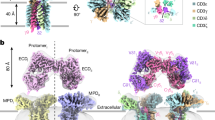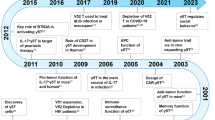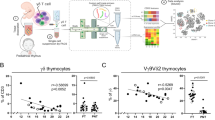Abstract
Although most mature peripheral T lymphocytes express a major histocompatibility complex restricted, CD3-associated, antigen receptor (TCR) which has been well characterized1–16, some T cells carry a different CD3-associated heterodimer on their surface17–22. One of the two disulphide-linked chains of this putative second receptor, which in mice has relative molecular mass (Mr) 35,000 (35K), has been identified as a product of the group of γ genes18. The other chain, termed δ (Mr 45K in mice), is not as well characterized. Although γ/δ-bearing cells are a minor subset among peripheral T lymphocytes, they are the only CD3+ cells in the thymus early in ontogeny19. Taking advantage of these kinetics, we have generated γ/δ-bearing hybridomas, using a new TCR α chain-negative variant of the AKR thymoma BW5147 as tumour parent, fetal thymocytes as normal cell partners, and an anti-CD3 monoclonal antibody (mAb) as screening reagent23. Gamma and δ chains from one of these hybrids have been purified and partially sequenced. The sequences obtained indicate that δ is indeed identical to the polypeptide encoded by the recently described gene X, as suggested by Chien et al.24.
This is a preview of subscription content, access via your institution
Access options
Subscribe to this journal
Receive 51 print issues and online access
$199.00 per year
only $3.90 per issue
Buy this article
- Purchase on SpringerLink
- Instant access to full article PDF
Prices may be subject to local taxes which are calculated during checkout
Similar content being viewed by others
References
1. Allison, P., Mclntyre, B. W. & Bloch, D. J. /. Immun. 129, 2293–2300 (1982). 2. Meuer, S. et al. J. exp. Med. 157, 705–719 (1983). 3. Haskins, K. et al J. exp. Med. 157, 1149–1169 (1983). 4. Kappler, J., Kubo, R., Haskins, K., White, J. & Marrack, P. Cell 34, 727–737 (1983). 5. Meuer, S. C. et al. Nature 303, 808–810 (1983). 6. Kappler, J. et al. Cell 35, 295–302 (1983). 7. Mclntyre, B. W. & Allison, J. P. Cell 34, 739–746 (1983). 8. Acuto, O., Meuer, S. C., Hodgdon, J. C., Schlossman, S. F. & Reinherz, E. C. J. exp. Med. 158, 1368–1373 (1983). 9. Yanagi, Y. et al. Nature 308, 145–149 (1984). 10. Hedrick, S. M., Cohen, D. I., Nielsen, E. A. & Davis, M. M. Nature 308, 149–153 (1984). 11. Hedrick, S. M., Nielsen, E. A., Kavaler, J., Cohen, D. I. & Davis, M. M. Nature 308, 153–158 (1984). 12. Acuto, O. et al. Proc. natn. Acad. Set. U.S.A. 81, 3851–3855 (1984). 13. Chien, Y. et al. Nature 312, 31–35 (1984). 14. Saito, H. et al. Nature 312, 36–40 (1984). 15. Sim, G. K. et al Nature 312, 771–775 (1984). 16. Hannum, C. H., Kappler, J. W., Trowbridge, I. S., Marrack, P. & Freed, J. H. Nature 312, 65–67 (1984). 17. Brenner, M. B. et al. Nature 322, 145–149 (1986). 18. Lew, A. M. et al Science 234, 1401–1405 (1986). 19. Pardoll, D. M. et al. Nature 326, 79–81 (1987). 20. Bluestone, J. A., Pardoll, D. M., Sharrow, S. O. & Fowlkes, B. J. Nature 326, 82–84 (1987). 21. Borst, J. et al Nature 325, 683–688 (1987). 22. Moingeon, P. et al. Nature 325, 723–726 (1987). 23. Leo, O., Foo, M., Sachs, D. H., Samelson, L. E. & Bluestone, J. A. Proc. natn. Acad. Sci. U.S.A.S4, 1374–1378(1987). 24. Chien, Y., Iwashima, M., Kaplan, K. B., Elliott, J. F. & Davis, M. M. Nature 327, 677–682 (1987). 25. Kubo, R. T. & Roehm, N. Molec. Immun. 23, 869–878 (1986). 26. Carman, R. D., Doherty, P. J. & Raulet, D. H. Cell 45, 733–742 (1986). 27. Hayday, A. C. et al Cell 40, 259–269 (1985). 28. Iwamoto, A. et al J. exp. Med. 163, 1203–1212 (1986). 29. Chien, Y. et al. Nature (in the press). 30. Lindsten, T., Fowlkes, B. J., Samelson, L. E., Davis, M. M. & Chien, Y. /. exp. Med. 166, 761–775 (1987). 31. Oettgen, H. C., Pettey, C. L., Maloy, W. L. & Terhorst, C. Nature 320, 272–275 (1986). 32. Konigsberg, W. H. & Henderson, L. Meth. Enzym. 91, 254–259 (1983). 33. Becker, D. M. et al. Nature 317, 430–434 (1985). 34. Barth, E. et al. Nature 316, 517–523 (1984). 35. Behlke, M. A., Chou, H. S., Huppi, K. & Loh, D. Y. Proc. natn. Acad. Sci. U.S.A. 83, 767–771 (1986). 36. Kabat, E. A., Wu, T. T., Reid-Miller, M., Perry, H. & Gottesman, K. S. Sequences of Proteins of Immunological Interest (US Dept Health and Human Services, 1987). 37. Smyth, D. G. Meth. Enzym. 11, 214–231 (1967).
Author information
Authors and Affiliations
Rights and permissions
About this article
Cite this article
Born, W., Miles, C., White, J. et al. Peptide sequences of T-cell receptor δ and γ chains are identical to predicted X and γ proteins. Nature 330, 572–574 (1987). https://doi.org/10.1038/330572a0
Received:
Accepted:
Issue date:
DOI: https://doi.org/10.1038/330572a0
This article is cited by
-
The emerging roles of γδ T cells in cancer immunotherapy
Nature Reviews Clinical Oncology (2023)
-
Does exercise attenuate age- and disease-associated dysfunction in unconventional T cells? Shining a light on overlooked cells in exercise immunology
European Journal of Applied Physiology (2021)
-
BW5147 and Derivatives for the Study of T Cells and their Antigen Receptors
Archivum Immunologiae et Therapiae Experimentalis (2020)
-
Gamma-delta (γδ) T cells: friend or foe in cancer development?
Journal of Translational Medicine (2018)
-
Role of gammadelta T cells in protecting normal airway function
Respiratory Research (2000)



